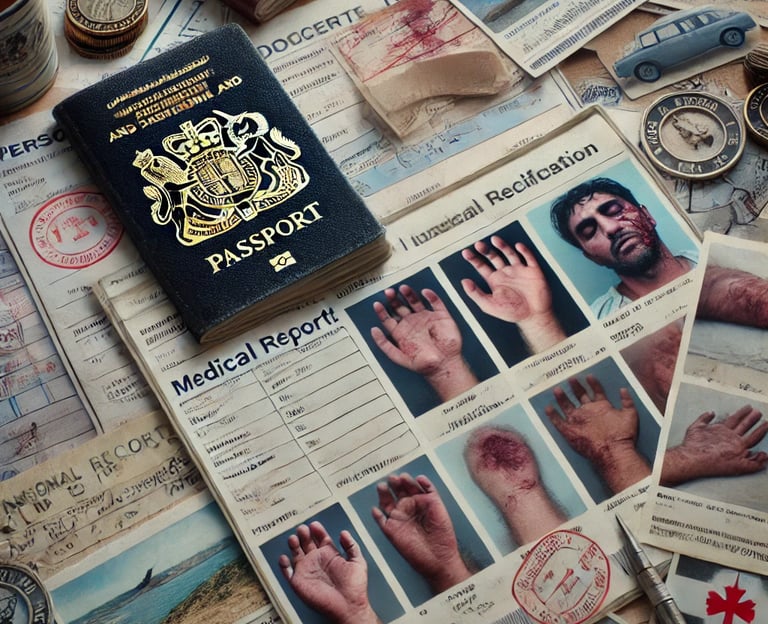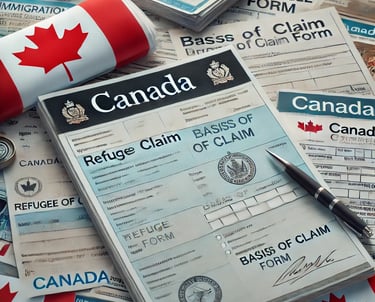How to File a Refugee Claim in Canada: A Step-by-Step Guide
Canada is known for its robust refugee protection system, offering safety to individuals fleeing persecution, war, and violence. Canada adheres to the national refugee claim process. If you're considering filing a refugee claim in Canada, this guide will walk you through the steps, helping you understand the process and what to expect along the way.


Step 1: Understanding Who Can Make a Refugee Claim
A refugee claim is a request for protection made by a person who fears returning to their home country due to persecution, threats, or violence. To file a claim in Canada, you must meet the criteria for protection under two main categories:
Convention Refugee: You fear persecution in your home country based on race, religion, political opinion, nationality, or membership in a particular social group (e.g., gender, sexual orientation).
Person in Need of Protection: You face a personal risk of torture, death, or cruel and unusual punishment if returned to your home country.


Passport or travel document
Identity documents (birth certificate, national ID card)
Proof of persecution (letters, police reports, medical records, newspaper articles)
Photos of injuries or threats
Family records or evidence of family members facing similar risks
Proof of residency in your home country
Make copies of all documents and have certified translations if they are not in English or French.
Before filing a refugee claim, it’s essential to gather all the necessary documentation to support your claim. These documents help prove your identity and the validity of your claim. Documents include:
Step 2: Gathering Required Documents
Step 3: Where to Make Your Refugee Claim
There are two main ways to file a refugee claim in Alberta:
At a Port of Entry (POE):
If you are entering Canada through an airport, land border, or seaport, you can make a refugee claim directly at the port of entry.
What to Expect at a Port of Entry:
Interview with an Officer: You will be interviewed by a Canada Border Services Agency (CBSA) officer or an Immigration, Refugees and Citizenship Canada (IRCC) officer. Be prepared to answer questions about your identity and reasons for seeking refugee protection.
Eligibility Determination: The officer will assess whether you are eligible to make a claim. You will need to demonstrate that you are facing a serious risk if returned to your home country.
Interim Federal Health Program: Once your claim is accepted, you may be eligible for the Interim Federal Health Program, providing access to healthcare services while your claim is being processed.
2. From Within Canada
If you are already in Canada and have entered the country legally, you can file a refugee claim at an IRCC office. You will need to call ahead to book an appointment. Alternatively, you can submit your refugee claim online through the Canadian Refugee Protection Portal


Step 4: Completing the Basis of Claim (BOC) Form
After your claim is accepted, you must complete a Basis of Claim (BOC) form. This form is a crucial part of your refugee claim, as it provides the detailed reasons why you are seeking protection. The form asks for:
Personal and family information
Detailed reasons why you fear returning to your home country
Supporting evidence (documents, reports, personal testimonies)
Make sure you provide as much detail as possible. It's recommended to seek legal advice from an immigration lawyer when completing this form, as it is a key part of your case.
Step 5: The Refugee Hearing
Once your claim is submitted, you will be scheduled for a refugee hearing at the Refugee Protection Division (RPD). The hearing is a critical stage in the process, where you will present your case in person.
Preparing for the Hearing:
Legal Representation: You have the right to hire a lawyer to represent you during your refugee hearing. It’s highly advisable to have legal representation to ensure that your claim is presented effectively.
Submit Additional Evidence: If new evidence becomes available after submitting your BOC form, you can submit it before your hearing.
Interpreters: If you are not fluent in English or French, an interpreter will be provided at the hearing.
At the Hearing:
You will present your claim and evidence.
An IRB member will ask you questions about your claim and may ask for clarification on your reasons for seeking asylum.
The IRB member will assess the credibility of your claim and the risk you face if returned to your home country.
Step 6: Decision and Aftermath
Refugee Claim Approved:
If your refugee claim is approved, you will be granted protected person status. This allows you to apply for permanent residency in Canada. Once your application is processed, you will become a permanent resident, with all the associated rights and privileges, including the right to work and study.
Refugee Claim Denied:
If your claim is denied, you may have the option to appeal the decision to the Refugee Appeal Division (RAD) or request a judicial review by the Federal Court. If these appeals are unsuccessful, you may be asked to leave Canada.
a. Eligibility to Appeal to the RAD
You are eligible to make an appeal to the RAD if the IRB's Refugee Protection Division (RPD) has denied your refugee claim and you meet the following conditions:
You received a negative decision on your refugee claim from the RPD.
You are in Canada (you cannot appeal if you are outside Canada).
Your case is not one of the exceptions listed below.
b. Cases Not Eligible for Appeal to the RAD
You cannot appeal to the RAD if:
Your claim was declared manifestly unfounded (the RPD found that your claim lacked any credible evidence from the start).
Your claim was deemed to have no credible basis (meaning the RPD believes there is no credible or trustworthy evidence supporting your claim).
You are a designated foreign national (individuals subject to specific laws for irregular arrivals).
Your claim was rejected due to a security or criminal concern under sections 34 to 37 of the Immigration and Refugee Protection Act (IRPA), such as being inadmissible for serious criminality.
Your claim was abandoned at the RPD (you failed to appear for your hearing or submit necessary documents).
If any of the above exceptions apply, you may still have the option to request a judicial review by the Federal Court.
c. Deadline for Filing an Appeal
The timeframe to appeal to the RAD is critical:
You must file your notice of appeal to the RAD within 15 calendar days after receiving your RPD decision.
You must submit all supporting documentation for your appeal (including written arguments and evidence) within 30 calendar days of receiving the RPD's written decision.
d. What the RAD Can Do
The RAD can:
Confirm the RPD's decision, upholding the denial of your claim.
Set aside the decision and either substitute a positive decision, granting you refugee protection, or return the claim to the RPD for further review.
The RAD typically bases its decision on the evidence and testimony already provided at the RPD hearing, but it may consider new evidence if it meets specific conditions (e.g., the evidence was not available at the time of the original hearing).
e. Appeal Process
To make an appeal, you need to:
File a Notice of Appeal: This document informs the RAD that you intend to challenge the RPD's decision.
Prepare and Submit Supporting Documents: Within 30 days, you must submit your arguments and any new evidence (if applicable) supporting why the RPD's decision was incorrect.
Wait for the Decision: The RAD will either review the case based on submitted documents or schedule an oral hearing if they feel more clarification is needed.
If the RAD dismisses your appeal, your only remaining option may be to seek a judicial review of the RAD’s decision in the Federal Court of Canada.
f. Judicial Review as an Alternative
If you're not eligible to appeal to the RAD, or if the RAD denies your appeal, you may file a judicial review with the Federal Court. This review checks for errors in law or procedure in the RPD or RAD's decisions but does not re-assess the facts of the case.


Step 7: Applying for Permanent Residency
Once you have received protected person status, you can apply for permanent residency. This process involves:
Completing the Permanent Resident Application (IMM 0008).
Submitting supporting documents (passport, ID, proof of refugee status).
Paying application fees.
Processing times vary, but once your application is approved, you will receive permanent resident status, allowing you to live, work, and access healthcare in Canada indefinitely.
Important Tips:
Seek Legal Advice: Refugee claims are complex, and having legal representation can increase your chances of success.
Stay Informed: Keep track of deadlines and document submission dates to avoid delays or denials.
Gather Strong Evidence: The more evidence you provide to support your claim, the stronger your case will be.
Language Assistance: If you do not speak English or French, always request an interpreter for interviews and hearings.
Conclusion
Filing a refugee claim in Canada is a multi-step process that requires preparation, documentation, and patience. It’s essential to follow the steps carefully, seek legal assistance when necessary, and ensure you meet all deadlines. By understanding the process and preparing thoroughly, you can increase your chances of successfully obtaining refugee protection in Canada.
If you are in Edmonton, Alberta and need help with your refugee claim, contact STEM LAW OFFICE for personalized guidance, assistance, and representation.
Flexible WEEKEND AND EVENING APPOINTMENTS AVAILABLE
Email: info@stemlaw.ca
TEL: 825-967-9007
© 2024. All rights reserved.
FAX: 587-838-2100


STEM LAW OFFICE
Address: 9360 - 34 Avenue
Edmonton, AB T6E 5T5
